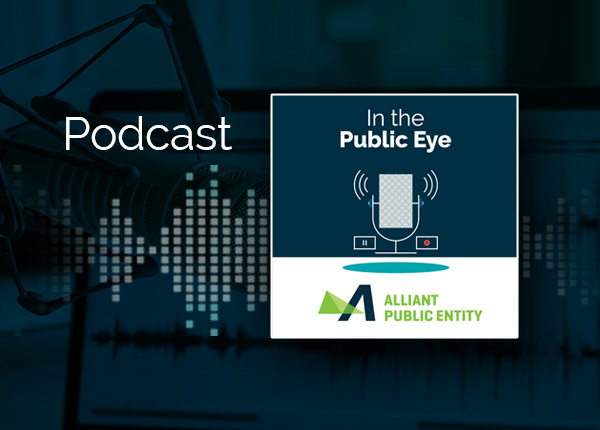In The Public Eye: Shifting Priorities of Employee Benefits in the Public Sector
By Alliant Specialty
Bob Treacy and Carleen Patterson, Alliant Public Entity, connect to identify new challenges facing employee benefits in the public sector. They discuss the shifting priorities of the developing workforce, the importance of attaining and retaining employees and how Alliant works with public entities to make strategic decisions for their employee benefit offerings.
Intro (00:00):
Welcome to the Alliant In The Public Eye podcast, a show dedicated to exploring risk management topics and challenges faced by today's public sector leaders. Here is your host, Carleen Patterson.
Carleen Patterson (00:18):
Welcome back everyone, to another episode of In The Public Eye. In the past few years, I've seen some changes in the industry with regard to risk management and employee benefits. There are times where we're seeing risk managers are being asked to take on benefits and vice versa, where benefits managers are being asked to take on risk management. Either way, public entities, I think, are facing challenges and pressures from both sides. So, while I've spent my career focusing on public entity risk management issues, I have a number of colleagues who have spent their careers working with public entities from a health and benefits perspective. So, I'm really excited today to have one of those colleagues, Bob Treacy, join me today. We're going to do a two-part series focusing on employee benefits. Today we're going to talk a little bit about benefits and the challenges, and then our next podcast, we'll go a little bit deeper into some of those challenges and maybe see how we and our clients are handling them. So, Bob, thank you very much for joining.
Bob Treacy (01:18):
Thank you very much for the opportunity, Carleen, and I'm just glad to be part of your collaborative realm out there.
Carleen Patterson (01:26):
So, Bob, you're a senior vice president in our public sector benefits practice. And so, maybe before we dive into the issues, tell our listeners a little bit about yourself and your experiences in this arena.
Bob Treacy (01:39):
Sure. Thank you so much again. When I got in this business, I go back that far in my career to the public sector. I found it early on and back in the eighties, and it's just been part of my identity. It's almost 40 years in the making. We just enjoy it, Nick and I, my partner joined earlier this year, the Alliant team coming from another national company firm. And all he's ever done is public sector. Nick always said something that always took home. Whenever we go into conferences, offices, wherever we are we want people to say, Hey, those guys are public sector, it's all we do. We're hundred percent all in. So, from a consulting standpoint, we have been doing this myself since 1985. Cities, counties, k12 school districts, political organizations in the employee benefit realm all the way up through today. And Nick has been in it for probably 15 years. Started with Aetna back in the day. So, this is what we do, Carleen, we understand the culture, the discipline, and all the cool things that really governments can use to gain leverage in the market.
Carleen Patterson (02:47):
Yeah, I think in today's world, you have to be specialized by industry because it varies so much from industry to industry. But having all those years of experience, what was it about Alliant that attracted you as an employee benefits professional?
Bob Treacy (03:05):
I think the thing that attracted us most about Alliant is, we had grown our business to a point where we needed more flexibility and more resources. Not only has it changed, as I said about just strictly the employee benefits side of that discipline, but again, all of the administrative codes, the legal issues, HR and our demand for the quality of our resources, the timelines that we work in government. The thing that's so unique about government is I could walk into a law firm tomorrow or an engineering firm and those folks could make a decision in one week, the CFO walks in, the CEO says, "Hey, what do you got? Oh, that's great. Do this, do that. Let's get it done. Let's go find the policies, let's go from there." But with government work, the timeline and the calendars are 90 to 120 days out.
Bob Treacy (04:03):
And what we saw was that we were working at a speed, a process velocity, that we needed the speed to get tighter on getting the outcomes that we needed from all these resources, be it compliance, human resources, doing budgeting and whatnot. Instead of waiting 30 days, we needed something like tomorrow. What we saw with Alliant is their ability to move at a fast speed, which is what government work a lot of times is because, Carleen, that budget work, CFO says, tear it up, do it again, I need it tomorrow. It's fast, the velocity is huge in government, even though the timelines are broad with the start and the end of a project with RFP work, we have to be quick. And we saw that Alliant had the resources necessary to get us on time with our clients and stay ahead of the game. And that was one of the things that caught our eye. The second thing was Alliant made it very clear when they searched us out that we to get bigger and government also in public sector. So, they were looking all around the market. I was happy to come to Alliant. So those are the two things that brought me to Alliant.
Carleen Patterson (05:17):
So, talking with your clients and looking at the resources that are available to them, how do you think the whole conversation has changed or evolved? A lot of times we used to think about HR and benefits being, buy your health insurance, and as long as there's health insurance, you're good. So, how do you think as benefits managers that their roles have changed and what do you see as some of their biggest challenges?
Bob Treacy (05:44):
Wow, you hit it right on the hip. From the standpoint of just driving benefits and I mean that blocking and tackling of doing RFP work and securing medical plans and voluntary benefit plans and dental, all that stuff hasn't really changed. The market is driven by leverage and the bigger the better. And Alliant brings strength and leverage to the markets. For Nick and I negotiate these deals, nothing has changed really there, but what I'm sensing for the first time when Nick and I talk to clients is they're asking us what other people are doing. And that signals to me that they're concerned about competing for a workforce. I'm hearing words like instead of human resources, human capital, we've heard for years about, well our best asset is our employees, but I'm not so sure that was it. When the market was wide open for competing for different areas of the public sector workforce, now it's changed.
There is so much competition for employees out there and our HR folks are very concerned about it. Public sector is all about that gold standard defined contribution plan, whether you're a city, a county, or a school district. And what's happening now is they're coming home to collect and all these senior managers who are really not senior, they're in their fifties, they're sitting here going, wow, I can retire now in my fifties and get 70 and 80% of my paycheck and go teach, substitute, or go do something else. And so, for the first time, it's not really about the benefits, it's not really about the compliance, it's not really about the administrative codes that we use. It's not really about the structure of the RFP, it's not really about all of that structural stuff. It's really about attaining and investing and training and then retaining a workforce.
Carleen Patterson (07:54):
Yeah. Well, and you mentioned pensions and over time the pension benefits that used to be differentiating for public entities, some of those have gone away and so they're not having those same type of the things that would make you go into public service versus work in the private sector or something. So, it is definitely a challenge. It's something I've been hearing on the risk side as well.
Bob Treacy (08:18):
Well, to that point, I'm having those conversations where, what HR folks and I touch base with HR folks all the time about what's going on, what are your hirees, what are you going through, what are you hearing? And I'll tell you, young people could care less about a retirement plan right now, you know, generation Z and whatever else we have coming on board here. These folks want a paycheck, and they want flexible work hours, and they want hybrid workplaces, and they want a salary. And I'm listening to the HR folks telling me that people are going another direction back to private sector for 50 cents an hour. I'm going, whoa. So, you know, we're facing a situation here where that old gold standard pension program of defined contributions that government really, that was their deal more than salaries. It's becoming very distant. And so, we're having to focus more on meeting these younger folks where they are, it's quite a changing dialogue. It really is.
Carleen Patterson (09:24):
To even compress the problem. And you mentioned people retiring in their fifties, but kind of to compress it because we're having such challenges keeping the workforce on the other end. Those who are getting near retirement are getting tired. It's a tough battle. And they're understaffed and have open positions, and so they're looking at retiring earlier for that very reason. So, you're right, it's kind of impacting on both ends.
Bob Treacy (09:52):
And to that end and we're in sync, Carleen, it seems like we're almost together in a presentation because I'm reading you and you're reading me here, and I've talked to HR folks recently about what are you doing differently? And as I said, it’s no longer human resources, it's human capital, these city managers and these county judges, they're reaching down to HR and they're very concerned about attaining and investing in these employees and what can we offer that others don't? And all the games are out there, all the strategies are out there. But again, for the first time, public sector is no longer taking this for granted. They have to figure out a way to come up with a strategy to have these young folks looking at them for employment for the first time. You're seeing all these city folks across Texas moving out to these beautiful rural areas of Texas and these great communities, and they're bringing all this private sector intel and how they're being treated in a private sector client.
And when they're talking to an HR director, a public sector, first of all, so many of those jobs are specialized, right? You can't just show up in a classroom and be a teacher. But in the area of running the business, they're trying to figure out a way to invest in these candidates for the long haul to retain them in the long run. Stable careers are a big thing public sector offers you're hearing all the time about these folks getting ghosted and laid off in private sector. Well, government doesn't do that for the most part. I mean, sure right now, property taxes, sales receipts, some kind of recession they say, but they generally don't lay off. It's a very stable career and that's a great place to launch from, right? I'm tired of getting laid off. I'm tired of getting fired. I'm tired of getting lost, what you have to offer me. Maybe not quite as many salary benefits, we can kick tail on. Nick and I have been designing benefits that rule over private sector. We can still do that, but they're interested in this workplace. If you want me to come back, what's it going to look like? I think stability's a big deal, years of service. And at some point, then guess what? That pitching plan begins to matter, right?
Carleen Patterson (12:07):
Yeah, absolutely. And I think it seems like our focus is a little bit, perhaps from a more professional standpoint when it comes to the workplace and that kind of thing. But public entities are charged with providing services to the public. And it's everything from collecting taxes and revenues and that kind of thing, all the way down to collecting garbage and having the folks there who are there to run the roots and make sure that those services are provided. And what I've been talking with my clients is they can't compete with private sector when it comes to the hourly wage, yet they still have to provide that service and how do they meet those demands? So, it's an interesting conversation and I think really talking about what are some of the things that public entities can do to differentiate themselves to attract that talent, I think is something that we really do need to dive into a little bit. When you're talking with your clients, have you had a chance to maybe discuss what is it that Alliant can do to help them differentiate? Have you had those types of conversations?
Bob Treacy (13:18):
The thing I love about Alliant is that there are no barriers to solutions. This is a private equity firm that believes in serving the client and serving their employees, meaning folks like us as consultants and account folks and whomever to get to the solution. That's what I talked about at the very beginning about the speed of the solution. We're getting more involved in these discussions, benchmarking, what are other cities doing? What other counties are doing, what are other school districts doing? I'm using it loosely now, but with the emergence of AI technology, the ability to use machines and computers to solve and make decisions, I think it's going to provide a quick linear pathway to getting data into our client's hands. And Alliant is supercharged with using AI, but at the same time too, data's great, but as you just said, Carleen, somebody has to collaborate and be in front of the client and put it to use. So, that's where I know you love that part. Give me the slide deck, give me the data, thank you very much. Give me the science, give me the engineering, give me the math, give me the outcomes. But then I've got to figure out a strategy. And so, this business with more useful data, we're spending more time in front of our clients. So, to answer directly your question, HR is becoming a big conversation.
Carleen Patterson (14:57):
Good! Well, I think that I really would want to explore a little bit more some of these challenges that you've touched on and also some of the things that you are doing, your team's doing to kind of address those, some of the what makes a benefits manager's job easier and some of the things that we do with that. So, I think this is a good place to stop and kind of introduce what we're going to talk about on our next podcast. So, I really do appreciate you joining me, and I'm excited that we're going to be able to talk again and kind of dive into this a little bit further. So, really appreciate your time today, Bob. Do recognize it's a very challenging time to be in public entity risk management and employee benefits, and so we're focused on providing continued information and resources as we navigate 2023 and beyond. We hope you enjoy this episode of In the Public Eye.
Alliant note and disclaimer: This document is designed to provide general information and guidance. Please note that prior to implementation your legal counsel should review all details or policy information. Alliant Insurance Services does not provide legal advice or legal opinions. If a legal opinion is needed, please seek the services of your own legal advisor or ask Alliant Insurance Services for a referral. This document is provided on an “as is” basis without any warranty of any kind. Alliant Insurance Services disclaims any liability for any loss or damage from reliance on this document.
Thanks for your message.
We’ll be in touch shortly.




